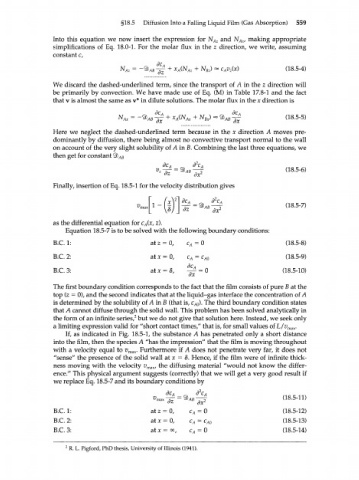Page 579 - Bird R.B. Transport phenomena
P. 579
§18.5 Diffusion Into a Falling Liquid Film (Gas Absorption) 559
Into this equation we now insert the expression for N and N , making appropriate
Az
Ax
simplifications of Eq. 18.0-1. For the molar flux in the z direction, we write, assuming
constant c,
N z = Э ^ + x (N Az + N ) « c v (x) (18.5-4)
-
A
A z
Bz
л в
A
We discard the dashed-underlined term, since the transport of A in the z direction will
be primarily by convection. We have made use of Eq. (M) in Table 17.8-1 and the fact
that v is almost the same as v* in dilute solutions. The molar flux in the x direction is
м. = —Q), D - + Y*(NA + Л Г С ) ~ 9 ) Л П - (18 S-S)
Here we neglect the dashed-underlined term because in the x direction A moves pre-
dominantly by diffusion, there being almost no convective transport normal to the wall
on account of the very slight solubility of A in В. Combining the last three equations, we
then get for constant ЯЬ АВ
v
z~j^ = ®AB —Ц (18.5-6)
Finally, insertion of Eq. 18.5-1 for the velocity distribution gives
| П ^ = Э „ ^ 08.5-7)
as the differential equation for c (x, z).
A
Equation 18.5-7 is to be solved with the following boundary conditions:
B.C.I: atz = 0, c = 0 (18.5-8)
A
B.C. 2: at x = 0, c = c AQ (18.5-9)
A
B.C.3: a t * = 5, ^ = 0 (18.5-10)
dx
The first boundary condition corresponds to the fact that the film consists of pure В at the
top (z = 0), and the second indicates that at the liquid-gas interface the concentration of A
is determined by the solubility of Л in В (that is, c ). The third boundary condition states
A0
that A cannot diffuse through the solid wall. This problem has been solved analytically in
2
the form of an infinite series, but we do not give that solution here. Instead, we seek only
a limiting expression valid for "short contact times," that is, for small values of L/v .
max
If, as indicated in Fig. 18.5-1, the substance A has penetrated only a short distance
into the film, then the species A "has the impression" that the film is moving throughout
with a velocity equal to v . Furthermore if A does not penetrate very far, it does not
max
"sense" the presence of the solid wall at * = 8. Hence, if the film were of infinite thick-
ness moving with the velocity v the diffusing material "would not know the differ-
max/
ence." This physical argument suggests (correctly) that we will get a very good result if
we replace Eq. 18.5-7 and its boundary conditions by
V max •>„ ^AB . т \LO.D-il.)
B.C.I: atz = 0, c = 0 (18.5-12)
A
B.C. 2: at x = 0, c = c (18.5-13)
A A0
B.C. 3: at x = oo, c = 0 (18.5-14)
A
2 R. L. Pigford, PhD thesis, University of Illinois (1941).

